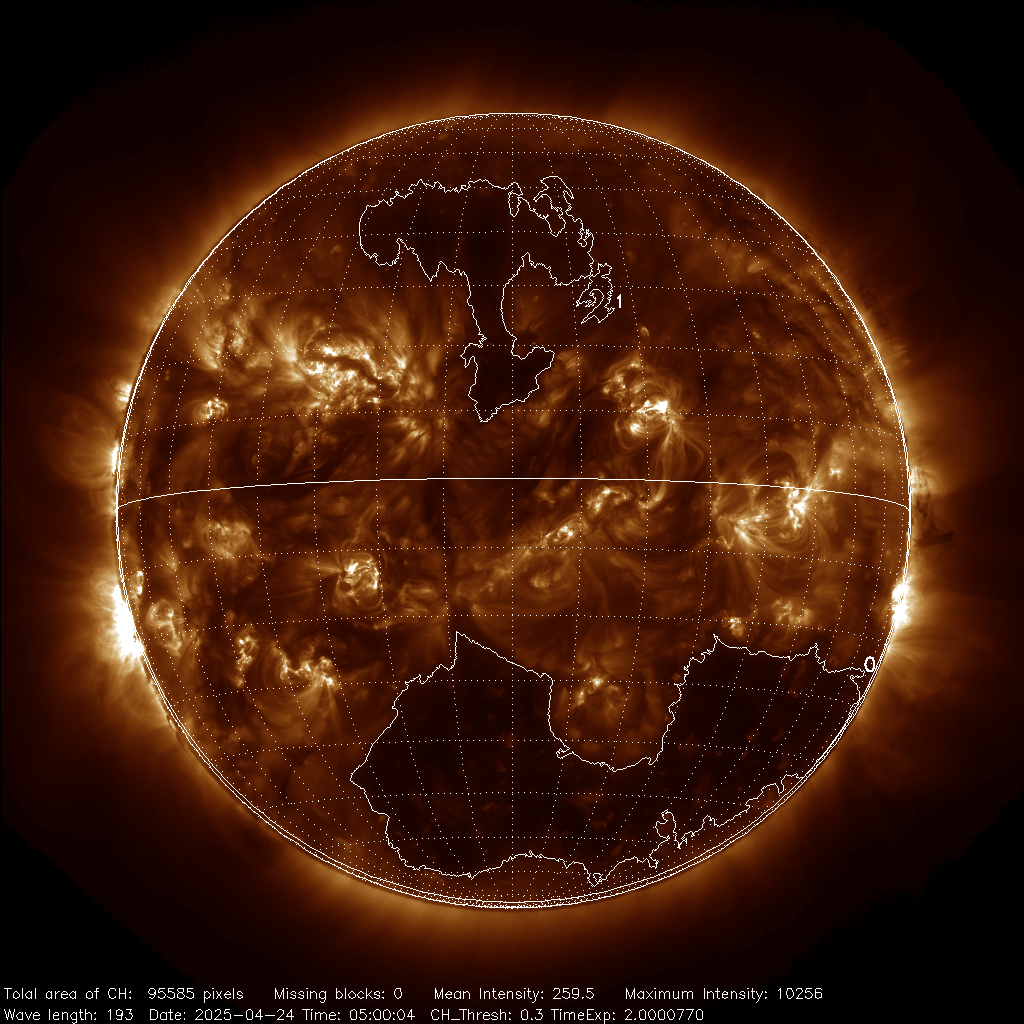SINP MSU Space Weather Analysis Center
Space Weather Analysis Centre of SINP MSU provides information about the current state of near-Earth's space. Information Services (SWX) on the website of the center provide access to current data describing the level of solar activity, geomagnetic and radiation state of the magnetosphere and the heliosphere in the real time. For data analysis, the models of the space environment, working in off-line as well as on-line mode have been implemented. Interactive services allow one to retrieve and analyze data in a given time moment. SWX is a flexible system for the analysis and forecasting of space weather in the near_Earth's space.
Current conditions in space (UT) |
 Coronal holes
Coronal holes

Recurrent high-speed solar wind streams (HSSWS) are one of the manifestations of solar activity. HSSWS are responsible for the moderate geomagnetic disturbances in all phases of the solar cycle. The source of the HSSWS are coronal holes (CHs) which appear as regions of decreased intensity in the ultraviolet and X-ray solar images due to low coronal plasma density and temperature.
The figure on the left shows the current image of the Sun provided by Atmospheric Imaging Assembly (AIA) instrument on the board of the Solar Dynamics Observatory (SDO) at a wavelength of 193 Å. CHs are highlighted with white contours on this image.
Parameters and location CHs are calculated based on automatic image analysis algorithm. Estimated CH parameters are used to forecast the value of SW velocity using various linear and non-linear methods. The "Space Weather" section shows images of the Sun at different wavelengths, as well as solar wind velocity forecast near the libration point L1.
 Magnetosphere today
Magnetosphere today
Earth's magnetosphere is the result of constant and active interaction between the supersonic flow of a magnetized, fully ionized plasma flowing from the solar corona, and its own magnetic field of the Earth. During this interaction, the head shock wave, magnetopause, and magnetospheric current systems are created. Large-scale currents in the Earth's magnetosphere determine the structure of the magnetic field and, therefore, the size and the position of plasma formations in near-earth space, the motion of energetic charged particles. The Earth's magnetosphere and the solar wind are in constant interconnection and represent a single system. Being under the constant influence of the solar wind, the Earth's magnetosphere displays variations in the parameters of the interplanetary medium, connected, both with active, and with cyclic processes on the Sun. The most striking manifestation of such impact explosive processes in the magnetosphere: magnetospheric substorms and magnetic storms, leading to a significant energy release in the inner magnetosphere. Along with this, the effects of the rotation of the Sun, an eleven-year solar cycle activity, are also confidently recorded according to the state of the magnetosphere, according to variations in the magnetospheric magnetic field.
The structure of the magnetic field (figure on the right) gives specialists an idea of the processes, occurring in the Earth's magnetosphere. To obtain a similar structure, numerical models of the magnetospheric magnetic field, Based on the theoretical assumptions, according to measurements, it is possible to construct a magnetic field cathrine in the entire magnetosphere. Together with measurements on space vehicles (spacecraft), this allows for full scientific research and build forecasts of space weather.
Watch magnetosphere in 3D
 Current Data from Russian Satellites
Current Data from Russian Satellites
|
|
|
|
Сurrent measurements of energetic charged particle fluxes at geostationary orbit obtained by satellite "Elektro-L2". "Elektro-L2" satellite is Russian hydrometeorological spacecraft launched on December 11, 2015 to the geostationary orbit (perigee — 35424.9 km; apogee — 35793.0 km; longitude — 77.8°; latitude — 0°). Green curve shows the variations of the flux of subrelativistic and relativistic electrons in the outer radiation belt of Earth (and also small additional flux of solar cosmic rays). The red curve characterizes the flux of solar protons at the geostationary orbit. |
The flux of energetic charged particles measured in the polar caps onboard the artificial satellite "Meteor-M2". The artificial satellite "Meteor-M2" is a Russian hydrometeorological spacecraft launched in July 2014 to the circular polar orbit (altitude 825 km, inclination 98.8°). Color lines show the average variations of flux of energetic charged particles, measured by the SCR device. |



